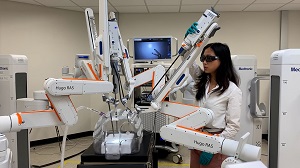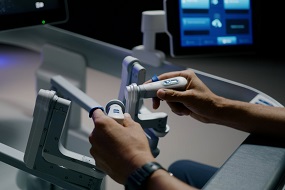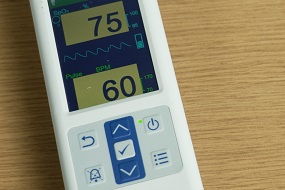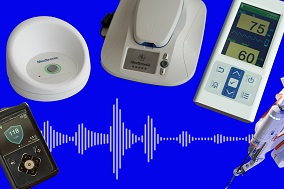Meet the healthcare technology soundscape
A five-part series on how device sounds are engineered with patients and healthcare providers in mind
In medical devices, sounds don’t stand alone. They’re an added layer of communication between devices and users.
As a sound engages more senses, the user has a better chance of understanding the intended message. This is called multimodal design: creating a user interface that coordinates different modalities –such as text on a screen, LED lights, vibration, use of colors, and sounds – to make sure the person using a device understands what’s needed as quickly as possible.
“Sound design is really a small but vital part of the holistic user experience,” said Jay Kamins, a user-experience designer in the Medtronic Surgical business. “If our system displays a message for the surgeon to read, an audio cue helps direct their focus to the text. Depending on the importance of the message, the sound can range from a mild ‘ping’ to an attention-grabbing high-severity alert.”
Multimodal design can be found in many Medtronic medical devices, but it’s perhaps most prominent in the new Medtronic Hugo™ robotic assisted surgery (RAS) system.
A comprehensive soundscape

The Hugo™ robotic-assisted-surgery (RAS) system, not currently approved for use in the United States, lets surgeons perform minimally invasive surgical procedures using robotic mechanical arms controlled from a master console.
“Since surgeons are not physically touching the patient, we want to design sounds that provide similar sensory feedback,” said Kamins “That’s why we try to create sounds that resemble the physical world — clicks, snaps, and small pings that are reminiscent of surgical instruments. The sounds become a bridge from the traditional to the robotic surgical experience.”
To that end, the Hugo™ RAS system boasts nearly two dozen sounds that engineers affectionately call earcons, the audible equivalent of a visual icon.
Earcons are meant to be easily recognizable. Hear one, and without any training, you can probably guess what it means. Lock the hand controllers, and the lock earcon sounds like a locking mechanism. And as you’d expect, the unlock earcon has the opposite sound.
The Hugo™ RAS system also incorporates a system progress earcon – a pulsing, whirling noise that lets users know the system is performing an action that’s not necessary visible, but must be completed before the surgeon can proceed.
Both are audible confirmations that the Hugo™ RAS system performed the function that the user intended.
Some sounds result from unexpected places – including video games.
IMPORTANT SAFETY INFORMATION
The Medtronic Hugo™ RAS system is commercially available in certain geographies. Regulatory requirements of individual countries and regions will determine approval, clearance, or market availability. In the EU, the Hugo™ RAS system is CE marked. In the U.S., the Hugo™ system is an investigational device not for sale. Touch Surgery™ Enterprise is not intended to direct surgery, or aid in diagnosis or treatment of a disease or condition.
L00108162023
Other stories in our Sound Up! Series:




